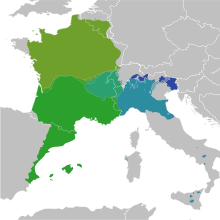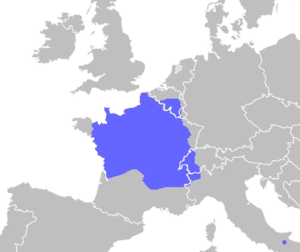Gallo-Romance languages
| Gallo-Romance | |
|---|---|
| Geographic distribution: | France, Northern Italy, San Marino, Monaco, Channel Islands, parts of Belgium and Switzerland |
| Linguistic classification: | |
| Subdivisions: | |
| Glottolog: | nort3208[1] |
|
Historical area of development for strict Gallo-Romance (Oïl languages and Arpitan). | |
The Gallo-Romance branch of the Romance languages includes French and the languages of northern Italy.[2][3][4] Based on mutual intelligibility, David Dalby counts seven languages: Gallo-Wallon, French, Franco-Provençal (Arpitan), Romansh, Ladin, Friulian, and Lombard.[5] However, other definitions are far broader, variously encompassing the Rhaeto-Romance languages, Occitano-Romance languages, and Gallo-Italic languages.
Classification
The Gallo-Romance group includes:
- The Langues d'oïl, or Oïl languages. These include Standard French, Picard, Walloon, Lorrain and Normand, Poitevin, Bourgignon. These are the most phonologically innovative Romance varieties.
- The Arpitan language, also known as Franco-Provençal, of southeastern France, western Switzerland, and Aosta Valley region of northwestern Italy. Formerly thought of as a dialect of either Oïl or Occitan, it is linguistically a language on its own, or rather a separate group of languages, as many of its dialects have little mutual comprehensibility. It shares features of both French and the Provençal dialect of Occitan.
Other language families which are sometimes included in the Gallo-Romance:
- The Rhaeto-Romance languages, including Romansh of Switzerland, Ladin of the Dolomites area, and Friulian of Friuli. Rhaeto-Romance can be classified as Gallo-Romance, or as a branch of the Western Romance languages. Rhaeto-Romance is a diverse group, with the Italian varieties influenced by Venetan and Italian and Romansh by Franco-Provençal.
- The Occitano-Romance languages of Southern France and neighbouring areas, includes Occitan and Catalan. Occitano-Romance can be classified as Gallo-Romance, Iberian Romance, or as a branch of the Western Romance languages.
- The Occitan language, or langue d'oc, has dialects such as Provençal dialect, and Gascon-Aranese dialect.
- The Catalan language has standard forms of Catalan and Valencian. The inclusion of Catalan in Gallo-Romance is disputed by some linguists who prefer to group it with Iberian Romance, since although Old Catalan is close to Old Occitan, it later adjusted its lexicon to some degree to align with Spanish. In general however, modern Catalan, especially grammatically, remains closest to modern Occitan than to either Spanish or Portuguese.
- The Gallo-Italic languages. They include Piedmontese, Ligurian, Western and Eastern Lombard, Emilian, Romagnol, Gallo-Italic of Sicily and Gallo-Italic of Basilicata. Gallo-Italic can be classified as Gallo-Romance, Italo-Dalmatian, or as a branch of the Western Romance languages. Ligurian and Eastern Lombard retain the final -o, being the exception in Gallo-Romance.
Traditional geographical extension

How far the Gallo-Romance languages spread varies a great deal depending on which languages are included in the group. Those included in its narrowest definition (i.e. the Langues d'oïl and Arpitan) were historically spoken in the north of France, parts of Flanders, Alsace, part of Lorraine, the Wallonia region of Belgium, the Channel Islands, parts of Switzerland, and northern Italy.
Today, a single Gallo-Romance language (French) dominates much of this geographic region (including the formerly non-Romance areas of France) and has also spread overseas.
At its broadest, the area also encompasses southern France, Catalonia, Valencia and the Balearic islands in eastern Spain, and much of northern Italy.
General characteristics
The Gallo-Romance languages are generally considered the most innovative (least conservative) among the Romance languages. Northern France (i.e. the medieval area of the langue d'oïl, out of which modern French developed) was the epicentre. Characteristic Gallo-Romance features generally developed earliest and appear in their most extreme manifestation in the langue d'oïl, gradually spreading out from there along riverways and roads. The earliest vernacular Romance writing occurred in Northern France, as the development of vernacular writing in a given area was forced by the almost total inability of Romance speakers to understand Classical Latin, still the vehicle of writing and culture.
Gallo-Romance languages are usually characterised by the loss of all unstressed final vowels other than /-a/ (most significantly, final /-o/ and /-e/ were lost). However, when the loss of a final vowel would result in an impossible final cluster (/tr/), a prop vowel appears in place of the lost vowel, usually /e/. Generally, the same changes also occurred in final syllables closed by a consonant.
Furthermore, loss of /e/ in a final syllable was early enough in Primitive Old French that the Classical Latin third singular /t/ was often preserved: venit "he comes" > /ˈvɛːnet/ (Romance vowel changes) > /ˈvjɛnet/ (diphthongization) > /ˈvjɛned/ (lenition) > /ˈvjɛnd/ (Gallo-Romance final vowel loss) > /ˈvjɛnt/ (final devoicing). Elsewhere, final vowel loss occurred later or unprotected /t/ was lost earlier (perhaps under Italian influence).
Other than southern Occitano-Romance, the Gallo-Romance languages are quite innovatory, with French and some of the Gallo-Italian languages rivaling each other for the most extreme phonological changes compared with more conservative languages. For example, French sain, saint, sein, ceint, seing meaning "healthy, holy, breast, (he) girds, signature" (Latin sānum, sanctum, sinum, cinget, signum) are all pronounced /sɛ̃/.
In other ways, however, the Gallo-Romance languages are conservative. The older stages of many of the languages are famous for preserving a two-case system consisting of nominative and oblique, fully marked on nouns, adjectives and determiners, inherited almost directly from the Latin nominative and accusative cases and preserving a number of different declensional classes and irregular forms.
In the opposite of the normal pattern, the languages closest to the oïl epicentre preserve the case system the best, and languages at the periphery (near languages that had long before lost the case system except on pronouns) lost it early. For example, the case system was preserved in Old Occitan until around the 13th century but had already been lost in Old Catalan, despite the fact that there were very few other differences between the two.
The Occitan group is known for an innovatory /ɡ/ ending on many subjunctive and preterite verbs and an unusual development of [ð] (Latin intervocalic -d-), which, in many varieties, merges with [dz] (from intervocalic palatalised -c- and -ty-).
The following tables show two examples of the extensive phonological changes that French has undergone. (Compare modern Italian saputo, vita even more conservative than the reconstructed Western Romance forms.)
| Language | Change | Form | Pronun. |
|---|---|---|---|
| Vulgar Latin | – | saˈpūtum | /saˈpuːtũː/ |
| Western Romance | vowel changes, first lenition | /saˈbuːdo/ | |
| Gallo-Romance | loss of final vowels | /saˈbuːd/ | |
| second lenition | /saˈvuːð/ | ||
| pre-French | final devoicing, loss of length | /saˈvuθ/ | |
| loss of /v/ near rounded vowel | /səˈuθ/ | ||
| early Old French | fronting of /u/ | seüṭ | /səˈyθ/ |
| Old French | loss of dental fricatives | seü | /səˈy/ |
| French | collapse of hiatus | su | /sy/ |
| Language | Change | Form | Pronun. |
|---|---|---|---|
| Vulgar Latin | – | vītam | /ˈviːtãː/ |
| Western Romance | vowel changes, first lenition | /ˈviːda/ | |
| early Old French | second lenition, loss of length, final /a/ to /ə/ | viḍe | /ˈviðə/ |
| Old French | loss of dental fricatives | vie | /ˈviə/ |
| French | loss of final schwa | vie | /vi/ |
Notable characteristics of the Gallo-Romance languages are:
- Early loss of all final vowels other than /ɡ/ is the defining characteristic, as noted above.
- Further reductions of final vowels in langue d'oïl and many Gallo-Italic languages, with the feminine /ɡ/ and prop vowel /e/ merging into /ə/, which is often subsequently dropped.
- Early, heavy reduction of unstressed vowels in the interior of a word (another defining characteristic). That and final vowel reduction are most of the extreme phonemic differences between the Northern and the Central Italian dialects, which otherwise share a great deal of vocabulary and syntax.
- Loss of final vowels phonemicised the long vowels that had been automatic concomitants of stressed open syllables. The phonemic long vowels are maintained directly in many Northern Italian dialects. Elsewhere, phonemic length was lost, but many of the long vowels had been diphthongised, resulting in a maintenance of the original distinction. The langue d'oïl branch was again at the forefront of innovation, with no less than five of the seven long vowels diphthongising (only high vowels were spared).
- Front rounded vowels are present in all four branches. /u/ usually fronts to /y/, and mid-front rounded vowels often develop from long /oː/ or /ɔː/.
- Extreme lenition (repeated lenition) occurs in many languages, especially in langue d'oïl and many Gallo-Italian languages. Examples from French: ˈvītam > vie /vi/ "life"; *saˈpūtum > su /sy/ "known"; similarly vu /vy/ "seen" < *vidūtum, pu /py/ "been able" < *potūtum, eu /y/ "had" < *habūtum.
- Langue d'oïl, Swiss Rhaeto-Romance languages and many northern dialects of Occitan have a secondary palatalization of /k/ and /ɡ/ before /ɡ/, producing different results from the primary Romance palatalisation: centum "hundred" > cent /sɑ̃/, cantum "song" > chant /ʃɑ̃/.
- Other than Occitano-Romance languages, most Gallo-Romance languages are subject-obligatory (whereas all the rest of the Romance languages are pro-drop languages). That is a late development triggered by progressive phonetic erosion: Old French was still a null-subject language until the loss of secondarily final consonants in Middle French.
Gallo-Italian languages have a number of features in common with the other Italian languages:
- Loss of final /s/, which triggers raising of the preceding vowel (more properly, the /s/ "debuccalizes" to /j/, which is monophthongized into a higher vowel): /-as/ > /-e/, /-es/ > /-i/, hence Standard Italian plural cani < canes, subjunctive tu canti < tu cantes, indicative tu cante < tu cantas (now tu canti in Standard Italian, borrowed from the subjunctive); amiche "female friends" < amicas. The palatalisation in the masculine amici /aˈmitʃi/, compared with the lack of palatalisation in amiche /aˈmike/, shows that feminine -e cannot come from Latin ae, which became /ɛː/ by the first-century AD, and could certainly have triggered palatalisation.
- Use of nominative -i for masculine plurals instead of accusative -os.
References
- ↑ Nordhoff, Sebastian; Hammarström, Harald; Forkel, Robert; Haspelmath, Martin, eds. (2013). "Northwestern Shifted Romance". Glottolog. Leipzig: Max Planck Institute for Evolutionary Anthropology.
- ↑ Charles Camproux, Les langues romanes, PUF 1974. p. 77–78.
- ↑ Pierre Bec, La langue occitane, éditions PUF, Paris, 1963. p. 49–50.
- ↑ G.B. Pellegrini, "Il cisalpino ed il retoromanzo, 1993". See also "The Dialects of Italy, edited by Maiden & Parry, 1997
- ↑ David Dalby, 1999/2000, The Linguasphere register of the world’s languages and speech communities. Observatoire Linguistique, Linguasphere Press. Volume 2. Oxford.
| ||||||||||||||||||||||||||||||||||||||||||||||||||||||||||||||||||||||||||||||||||||||||||||||||||||||||||||||||||
| ||||||||||||||||||
|
